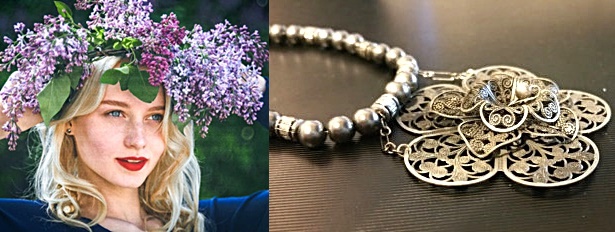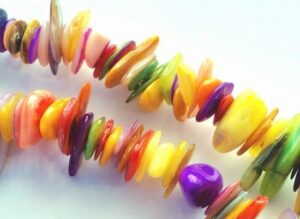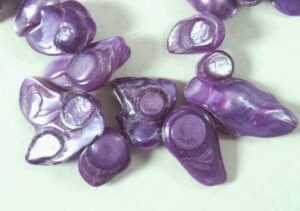Cinnabar, Flower Beads & Pearls For June
22nd May 2021
 Small bead fairs are back! Our first is Norwich Bead Fair, tomorrow, 23rd May 2021!
Small bead fairs are back! Our first is Norwich Bead Fair, tomorrow, 23rd May 2021!
Then we’re at Luton Bead Fair Saturday 5th June and Essex MrBead Fair on Sunday 6th June. All free entry, free refreshments & free gifts! We have booked 18 others so far this year, see at 2021 Bead Fairs.
New MrBead Shop: https://mrbeadshop.com
Content:
Cinnabar Beads
Flower Beads
The Secrets of Pearls
What Is Mother-Of-Pearl?
Glass Pearls
Knotting a Pearl Necklace
How To Tell Real From Fake Pearls
Bead Fairs Confirmed On
Join Newsletter
 We’re getting popular on Instagram! Tweet a link to all your followers – just click here. Join our 15,000 fans and follow us on Twitter at MrBead@UKMrBead and Nigel at Nigel@NigelMckay
We’re getting popular on Instagram! Tweet a link to all your followers – just click here. Join our 15,000 fans and follow us on Twitter at MrBead@UKMrBead and Nigel at Nigel@NigelMckay
Our New MrBead Shop: https://mrbeadshop.com
15% Off All From MrBead
Enjoy the new shop with 15% off anything with no minimum order. This is £15 off £100 worth of beads – the more you spend: the more you save! Only once per customer.
Shipping is free too on UK orders over £30 – under this UK P&P is just £2.50. International shipping from £5.
Can only be used at the NEW shop & not with any other coupon. To get the discount Key PEARLS at checkout now, as offer ends Friday 28th May 2021. Use at https://mrbeadshop.com.
Cinnabar Beads
 The vivid red of cinnabar beads makes dramatic jewellery. Red is the colour of energy, passion, courage, power, and desire. Use cinnabar beads to stand out in necklaces, earrings or pendants.
The vivid red of cinnabar beads makes dramatic jewellery. Red is the colour of energy, passion, courage, power, and desire. Use cinnabar beads to stand out in necklaces, earrings or pendants.
 The Root Chakra, where energy flows from, is red because it’s the most-stimulating colour. It’s stable and grounding. Red is linked to our most primitive physical and emotional needs of survival and self-preservation.
The Root Chakra, where energy flows from, is red because it’s the most-stimulating colour. It’s stable and grounding. Red is linked to our most primitive physical and emotional needs of survival and self-preservation.
 Technically, Cinnabar is mercury sulfide, found near recent volcanic activity. Its name comes from Medieval Latin ‘cinnabaris’; Red lead. Because of its red colour, powdered cinnabar was used during ancient times for “war” and ceremonial face and body paint. It was popular in ancient Greece and 16th-century Spain.
Technically, Cinnabar is mercury sulfide, found near recent volcanic activity. Its name comes from Medieval Latin ‘cinnabaris’; Red lead. Because of its red colour, powdered cinnabar was used during ancient times for “war” and ceremonial face and body paint. It was popular in ancient Greece and 16th-century Spain.
 The Romans used it for lipstick, despite the toxicity of mercury in cinnabar being well known before 2000 B.C – when slaves and prisoners mining the ore died after three-years. However, the Chinese during the Song Dynasty, reduced the risk by using lacquer over the cinnabar carvings onto chests, candle sticks, snuff bottles and other ornaments.
The Romans used it for lipstick, despite the toxicity of mercury in cinnabar being well known before 2000 B.C – when slaves and prisoners mining the ore died after three-years. However, the Chinese during the Song Dynasty, reduced the risk by using lacquer over the cinnabar carvings onto chests, candle sticks, snuff bottles and other ornaments.
 Today, the toxic pigment is replaced by a resin-based polymer that looks the same as the pigmented lacquer. Most beads and jewellery sold as cinnabar now, consist of a carved wood base covered by layers of resin, and are totally harmless.
Today, the toxic pigment is replaced by a resin-based polymer that looks the same as the pigmented lacquer. Most beads and jewellery sold as cinnabar now, consist of a carved wood base covered by layers of resin, and are totally harmless.
Click To See All Our Cinnabar Beads
Flower Beads


 Flower beads make great spring and summer jewellery. Flowers represent freshness and growth.
Flower beads make great spring and summer jewellery. Flowers represent freshness and growth.
You can use large flower beads as the focal for a necklace, or smaller ones in a bracelet or earring. Try mixing different colours and/or shape flower beads in a design, along with silver flower spacers.

 Floral motifs were used in antique rings, bracelets, pendants and brooches. All forms of flowers have always been popular in jewellery.
Floral motifs were used in antique rings, bracelets, pendants and brooches. All forms of flowers have always been popular in jewellery.

 Saying it with flowers has been passed down throughout the centuries. Like red roses or tulips declaring love, forget-me-nots for remembrance, and Lily of the Valley symbolised a return to happiness. All ladies love flowers, making any floral jewellery popular.
Saying it with flowers has been passed down throughout the centuries. Like red roses or tulips declaring love, forget-me-nots for remembrance, and Lily of the Valley symbolised a return to happiness. All ladies love flowers, making any floral jewellery popular.
Click To See All Our Flower Beads
THE SECRETS OF PEARLS
Pearls Are For June
Pearl Jewellery Sells!
 If you want to make quality, impressive jewellery that everyone appreciates, then go for pearls. Everyone loves pearls. They are so versatile – always looking good on any necklace, bracelet, earring or pendant. Pearl is the gemstone for June.
If you want to make quality, impressive jewellery that everyone appreciates, then go for pearls. Everyone loves pearls. They are so versatile – always looking good on any necklace, bracelet, earring or pendant. Pearl is the gemstone for June.
Pearls are expected to be expensive and in short supply
 The reason is that people understand pearls are natural. However, since the 1950s, natural pearls have been cultivated by man – making them much cheaper to buy. This means that including them in jewellery, you will make you even more profit!
The reason is that people understand pearls are natural. However, since the 1950s, natural pearls have been cultivated by man – making them much cheaper to buy. This means that including them in jewellery, you will make you even more profit!
The pearl is the queen of gems and the gem of queens
What are Cultured Pearls?
 The least expensive cultured pearls today rival the most expensive natural pearls ever found. Cultured freshwater pearls occur in mussels for the same reason saltwater pearls occur in oysters.
The least expensive cultured pearls today rival the most expensive natural pearls ever found. Cultured freshwater pearls occur in mussels for the same reason saltwater pearls occur in oysters.
Foreign material inside a mussel can’t be expelled. To reduce irritation, the mollusk coats the intruder with the same secretion it uses for shell-building, nacre. To cultivate a pearl, farmers slit the mussel and insert small pieces of live tissue from another mussel.
 The ancient Chinese practiced this technique, but the first real cultured freshwater pearls originated from Japan in the 1930’s.Japanese farmers by Lake Biwa achieved natural colours previously unseen in saltwater pearls.
The ancient Chinese practiced this technique, but the first real cultured freshwater pearls originated from Japan in the 1930’s.Japanese farmers by Lake Biwa achieved natural colours previously unseen in saltwater pearls.
However, water pollution today has virtually destroyed pearl production there.
 China now has the resources that Japan lacks: many large lakes, rivers, and a low-cost work force. China has now revolutionized pearling – shapes, lustre, and colours of Chinese pearls now surpass Biwa quality.
China now has the resources that Japan lacks: many large lakes, rivers, and a low-cost work force. China has now revolutionized pearling – shapes, lustre, and colours of Chinese pearls now surpass Biwa quality.
Copying the Japanese to improve off-white and mottling, China uses a mild bleach, bright lights, and heat. Natural freshwater pearls are usually odd shapes. So for more roundness, they reshape rejected pearls into spheres, and then nucleate mussels with them.
 Freshwater pearls are popular for their colours: white, silvery-white, pink, red, copper, brown, lavender, purple, green, blue, and yellow.
Freshwater pearls are popular for their colours: white, silvery-white, pink, red, copper, brown, lavender, purple, green, blue, and yellow.
The most desirable are the pastel pinks, roses, lavenders, and purples. Natural colour comes from the mussel species and water quality – with pearls taking the colour of the shell in which they form. However, permanent dyes are used today for most saturated colours.
The Best Pearls
 Good pearls have thick overlapping layers of nacre. This can be tested by viewing its “lustre”. Roll the pearl with a pen in bright light – the best pearls will reflect the pen more.
Good pearls have thick overlapping layers of nacre. This can be tested by viewing its “lustre”. Roll the pearl with a pen in bright light – the best pearls will reflect the pen more.
A large pearl is only more valuable if it’s the same quality as a smaller one – the rounder the better. Being an organic gem, grooves, pits, or dents are expected.
What is Mother-of-Pearl?

 The shining, playful, reflected light of mother-of-pearl has attracted attention since ancient times. The natural material has always been popular.
The shining, playful, reflected light of mother-of-pearl has attracted attention since ancient times. The natural material has always been popular.
 From then, different technology has turned mother-of-pearl into many uses, apart from jewellery. Today, it’s dyed every colour under the sun – creating attractive jewellery at affordable prices.
From then, different technology has turned mother-of-pearl into many uses, apart from jewellery. Today, it’s dyed every colour under the sun – creating attractive jewellery at affordable prices.
 The mollusk forms mother-of-pearl as a protective shell. Like the pearl it’s a secretion of the mantle, composed of alternate layers of calcium carbonate and conchiolin. Among the chief sources are pearl oysters from the tropical seas.
The mollusk forms mother-of-pearl as a protective shell. Like the pearl it’s a secretion of the mantle, composed of alternate layers of calcium carbonate and conchiolin. Among the chief sources are pearl oysters from the tropical seas.
See our Mother of Pearl Beads
Glass Pearls
 As the name, these are coated glass to look like the best quality pearls possible. Any pearl that is a perfect round shape without any grooving, will either cost thousands of pounds or made of glass!
As the name, these are coated glass to look like the best quality pearls possible. Any pearl that is a perfect round shape without any grooving, will either cost thousands of pounds or made of glass!
However, glass pearls are fantastic value for money and have a big place making affordable fashion jewellery. To see our colourful range of glass pearls at under £1.25 a string, click here.
Matching Pearls
 Matching pearls isn’t easy, but is important when planning jewellery. It’s an art in itself, requiring a sharp eye, excellent judgment, and experience. Try to buy all the pearls for a project at the same time, as later batches may not match your original purchase. When balancing pearls for jewellery, you need to consider:
Matching pearls isn’t easy, but is important when planning jewellery. It’s an art in itself, requiring a sharp eye, excellent judgment, and experience. Try to buy all the pearls for a project at the same time, as later batches may not match your original purchase. When balancing pearls for jewellery, you need to consider:
- How the pearls blend together in colour, shape, lustre, size and surface perfection.
- How smooth the size increase is of pearls in graduated strands.
- If a necklace is part of a set, all of its pearls on earrings, bracelets or whatever, must match. However, don’t put too much attention perfectly matching against other factors.
See All Our Pears At: Pearl Beads
Knotting a Pearl Necklace
 If you look closely, you’ll see tiny knots in between each pearl on a good necklace. This prevents the pearls rubbing against each other – and if the necklace breaks, beads won’t go flying. Knotting also makes the necklace drape nicely and adds length so you need less pearls.
If you look closely, you’ll see tiny knots in between each pearl on a good necklace. This prevents the pearls rubbing against each other – and if the necklace breaks, beads won’t go flying. Knotting also makes the necklace drape nicely and adds length so you need less pearls.
 Pearls should be restrung every few years, depending on wear and exposure to hair spray, perfume, body oils, lotions, moisture, and perspiration. This weakens the silk and cause a potential break point for the strand.
Pearls should be restrung every few years, depending on wear and exposure to hair spray, perfume, body oils, lotions, moisture, and perspiration. This weakens the silk and cause a potential break point for the strand.
There’s a few ways to knot a beaded necklace, but this is the easiest for beginners. First choose a type of cord. There are two types for knotting: silk and nylon. Silk is traditional, however many complain that it snags and frays. Nylon cord can also be used. Both come in a variety of colours.
They can be purchased on small cards with about 6 feet of cord and a needle attached – or for the serious knotter, larger spools can be purchased with separate needles. They also come in different sizes. The thicker cord is used for larger beads.
For beginner’s technique, two strands are put through each bead, so a thinner size is needed. For 6mm beads, use size 2 for this technique, and try to match the colour of the cord with the colour of the beads.
A popular way to start any beaded necklace is with bead tips. The only difference here is that two strands of the cord are inserted through the bead tip instead of one. This is easier than using one strand of cord, and the results look almost the same.
- Once the necklace is started, string on a bead, and make an over hand knot.
- Make the knot tight so it’s snug up against the bead.
- Continue to do this: string a bead, make an over hand knot, string a bead, make an over hand knot.
- Finish the necklace as you would any beaded necklace whether it’s knotted or not.
How to Tell Real from Fake Pearls
You can identify fake pearls by what they’re called: simulated, faux, glass, plastic, resin, artificial, manmade. Genuine pearls will be called natural, cultured, freshwater, or sea.
Real pearls may come from either freshwater or saltwater, and it’s very difficult to tell which – both form in a variety of molluscs (not just oysters). However, all grow the same way in baroque shapes as well as round. There are also shell pearls and genuine pearls which have been artificially coated or dyed. Before you deal in pearls, you need to know if they’re natural or not.
Professional Testing
If you want to buy expensive pearls that are perfectly matched, a gemmologist certificate (from one of your choice) is essential. It costs about £100 to have pearls tested, as opposed to several-thousands for the type that warrant the test. An x-ray will show variations in density the inside of the pearl, a parasite that might have caused the formation of a natural pearl, and the characteristic shapes of drill holes.
The Tooth Test
 Rub the surface of the pearl over your teeth – a real pearl feels gritty, while a faux pearl feels smooth. Real pearls are made up of layers of nacre that are deposited like sand on a beach. The slight waves in the nacre give a bumpy feeling against the teeth. However, if the pearls are dyed, the dye can fill in natural depressions.
Rub the surface of the pearl over your teeth – a real pearl feels gritty, while a faux pearl feels smooth. Real pearls are made up of layers of nacre that are deposited like sand on a beach. The slight waves in the nacre give a bumpy feeling against the teeth. However, if the pearls are dyed, the dye can fill in natural depressions.
Close Inspection
Look at the pearls in bright light. Unless they’re very expensive, genuine pearls will have slight variations in shape, size and colour – along with grooves in their nacre, bumps, ridges, or pits. Otherwise, or if any are a perfect sphere or have a grainy smoothness: they’re suspect.
Cutting a pearl open will reveal its true nature. Natural pearls are comprised of many layers of nacre. Cultured pearls have a mother-of-pearl shell core covered with a thin layer of nacre. Fake pearls have a core with one or more layers of coating which tends to flake away on cutting.
Pearl Holes
Examine drill holes to see the nacre layers and what lies beneath. Real pearls are usually drilled from both sides to meet in the middle – making the hole appear wider at the outside edge of the pearl. Holes of fake pearls are usually strait and are more likely to be larger all the way through. The nacre of fake pearls near the drill holes, flakes away easier than on a natural pearls. And cheap real pearls may not be drilled straight, making a necklace hang badly, unless it’s knotted.
Other Clues
Sometimes fakes are made to look irregular, and glass pearls often have flattened ends. Genuine pearls warm to the skin faster than glass pearls – while plastic pearls tend to feel warm right away.
 Real pearls are heavier for their size than any fakes. Other signs are in the pearl’s surroundings. A genuine pearl necklace is more likely to be knotted and set in gold, silver, or platinum. You can examine clasps for stamps in the metal. The clasp should have a safety mechanism, like a fish hook. No one would use insecure clasps on good pearls.
Real pearls are heavier for their size than any fakes. Other signs are in the pearl’s surroundings. A genuine pearl necklace is more likely to be knotted and set in gold, silver, or platinum. You can examine clasps for stamps in the metal. The clasp should have a safety mechanism, like a fish hook. No one would use insecure clasps on good pearls.
Faux Pearls
Faux pearls, although manmade, are not necessarily a cheap substitute to the real thing. They have genuine beauty of their own, looking “almost” the same as natural pearls costing thousands of dollars. They’re created by coating the outside of glass or plastic beads with pearl powder. This is then dipped into various solutions of pearl film to simulate the lustre of a natural pearl.
Pearl Folk Lore
There are an almost infinite number of myths and folk lore associated with pearls. Many pearl web sites included their own version of pearl myths. Here are a few that I found:
- Pearls have the powers of love, money, protection, and luck.
- Pearls were dedicated by the Romans to Isis and they were worn to obtain her favour.
- In early Chinese myths, pearls fell from the sky when dragons fought among the clouds.
Pearl Care
Special care is needed for pearls. Since they are naturally porous, it’s important to make sure they do not absorb cologne, hair spray, lotions, or make up. Although oils from your skin help keep the pearls from drying out. Pearl jewellery is often purchased in a silk or felt pouch. You should keep the pearls in this to prevent scratches. To clean pearls, don’t use any jewellery cleaners – wipe gently with a damp cloth.
Click To See All Our Many Pearl Beads
Next Newsletter: All About Shell Beads
Bead Fairs Confirmed On
 Please come to visit us and see our beads ‘in the flesh’! All shows will be socially distanced and a limit to the numbers in the hall at any one time.
Please come to visit us and see our beads ‘in the flesh’! All shows will be socially distanced and a limit to the numbers in the hall at any one time.
If anyone would like to exhibit (for free!) at Essex on Sunday 6th June, just email me. No free space in the other fairs. Click the show’s name below for more info:
Sunday 23rd May 11am-4pm: Norwich Bead Fair, The George Best Western Hotel, Norwich NR2 2DA
Saturday 5th June 11am-4pm – Luton Bead Fair, The Stockwood Hotel, Luton LU1 3SS – 1/2-hour up the M1 from London.
Sunday 6th June 11am-4pm: Essex MrBead Bead Fair, Great Bromley Village Hall, Gt Bromley, Colchester CO7 7JA.
Sunday 4th July 10.30am-4pm: Cornish Probus Bead Fair, Probus Village Hall, Probus TR2 4NB.
Weekend 10th-11th July 10am-4pm: Lyndhurst Gem n Bead Fair, Lyndhurst Community Centre, Lyndhurst SO43 7NY.
Sunday 18th July 11am-4pm: Norwich Bead Fair, The George Best Western Hotel, Norwich NR2 2DA
Full List of All 19 Bead Fairs Booked So Fair at: Bead Beads 2021
15% Off All From MrBead
Enjoy the new shop with 15% off anything with no minimum order. This is £15 off £100 worth of beads – the more you spend: the more you save! Only once per customer.
Shipping is free too on UK orders over £30 – under this UK P&P is just £2.50. International shipping from £5.
Can only be used at the NEW shop & not with any other coupon. To get the discount Key PEARLS at checkout now, as offer ends Friday 28th May 2021. Use at https://mrbeadshop.com.

